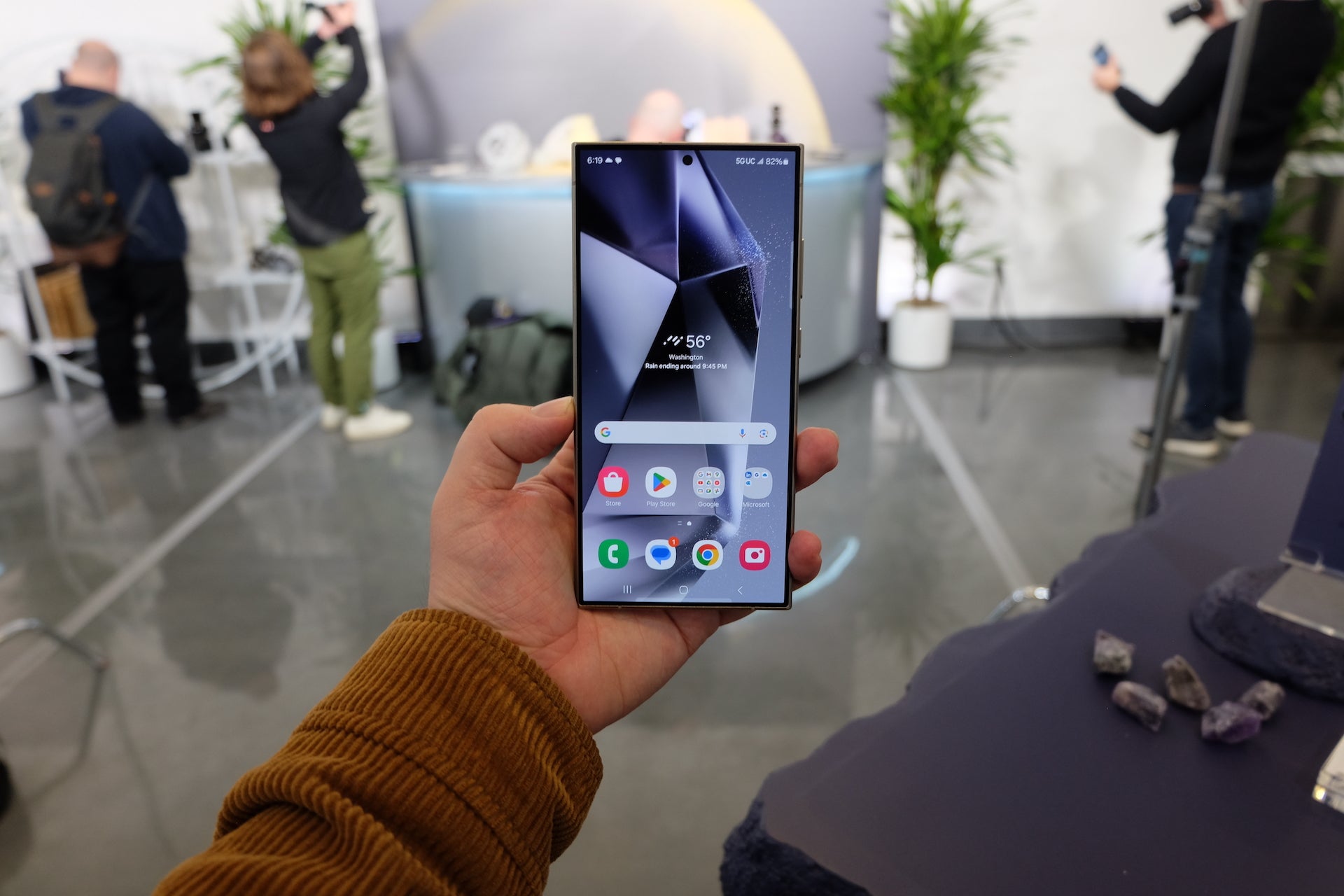First Impressions
If you remove Galaxy AI, the Galaxy S24 Plus feels like a minor upgrade. Yes, you get a brighter screen and a newer chip but the design is very familiar and there isn’t much that feels new. However, if Galaxy AI turns out to be the real deal, this could be one to consider in 2024.
-
Bigger, brighter, better screenThe S24 Plus’ screen is not only 0.1 inches bigger than its predecessor at 6.7 inches, but it also boasts high-end tech like a LTPO-enabled 120Hz refresh rate and a maximum brightness of 2600nits to boot. -
A new focus on GenAIWith Galaxy AI, the S24 Plus can do some pretty impressive stuff, from transcribing and translating meetings to removing elements from your photos – and it all happens entirely on-device. -
Top-end performanceDespite the chipset split, regardless of whether you get the Exynos 2400 for Galaxy or Snapdragon 8 Gen 3 for Galaxy, you’ll find top-end performance with dedicated support for Generative AI.
Introduction
January is looking like a very busy month for phone launches and Samsung has kicked things off with the reveal of the Samsung Galaxy S24 series.
The Galaxy S24 Plus is the middle child of this range, offering mostly the same specs as the Galaxy S24, just with a bigger screen and battery. Then there’s the Galaxy S24 Ultra, with more camera skills and handy additions like the S Pen.
Ahead of the launch and the latest Unpacked, I had the chance to get an early look at the Galaxy S24 Plus and try out its headline Galaxy AI features.
Design and Screen
- Four new colours
- Larger, brighter OLED screen
- 1-120Hz adaptive refresh
Samsung isn’t shifting too far away from the design of the S23 Plus with the S24 Plus. It still matches the look of the smaller S24 model, mirroring the iPhone 15 in many ways with its flat sides and back.
The size, at least for me, is nearly perfect on this Plus model. It’s far comfier to hold than the larger (and heavier) S24 Ultra, while offering a more usable 6.7-inch screen than the slightly cramped 6.2-inch Galaxy S24.
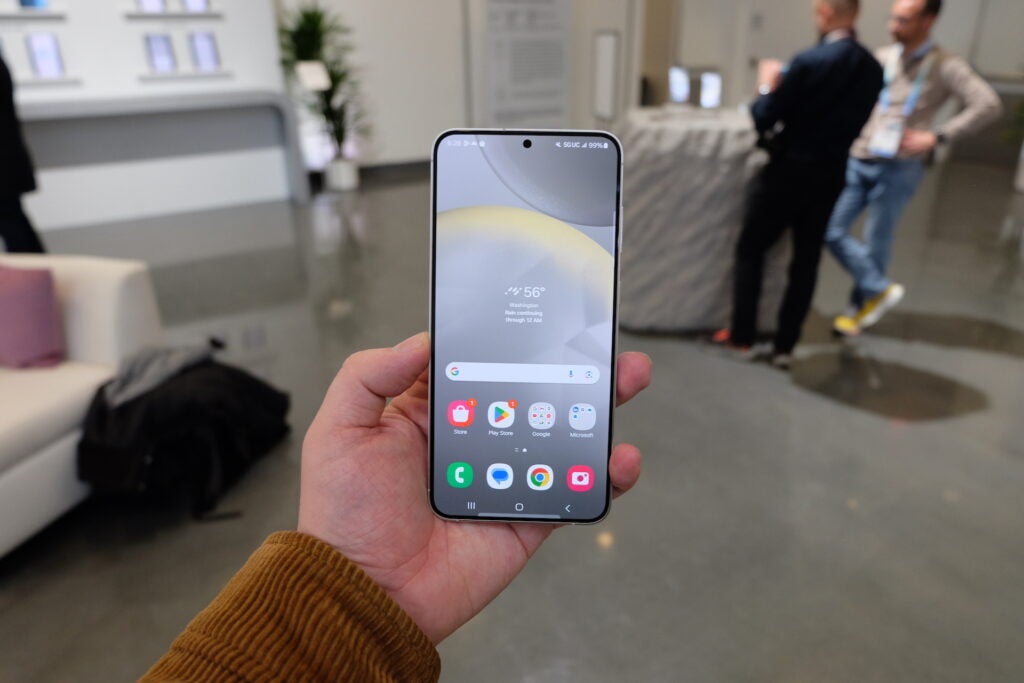
All the dimensions are very similar to the outgoing S23 Plus, however Samsung did say it has slimmed the bezel down slightly to gain a 0.1-inch larger screen and that the hole punch cutout for the front camera has been reduced in size. I didn’t have an S23 Plus to hand during my briefing ahead of the launch, but you’ll likely only notice these two differences if you’re coming from last year’s model.
Aside from a minor bump in size, there is a smattering of other screen updates. It remains an AMOLED panel, but it can now alter its refresh rate between 1 and 120Hz, matching the previous Ultra devices. Samsung says the panel can now reach 2600 nits, and it should be even easier to read outside. I was shown a demo of how the S24 Plus would perform when used in direct sunlight and it did look very impressive.
Samsung has simplified the colours this time too, using the same four main hues for all models in the S24 family. These include blue, white, black and yellow. There will also be some extra exclusive colours only available via Samsung directly.
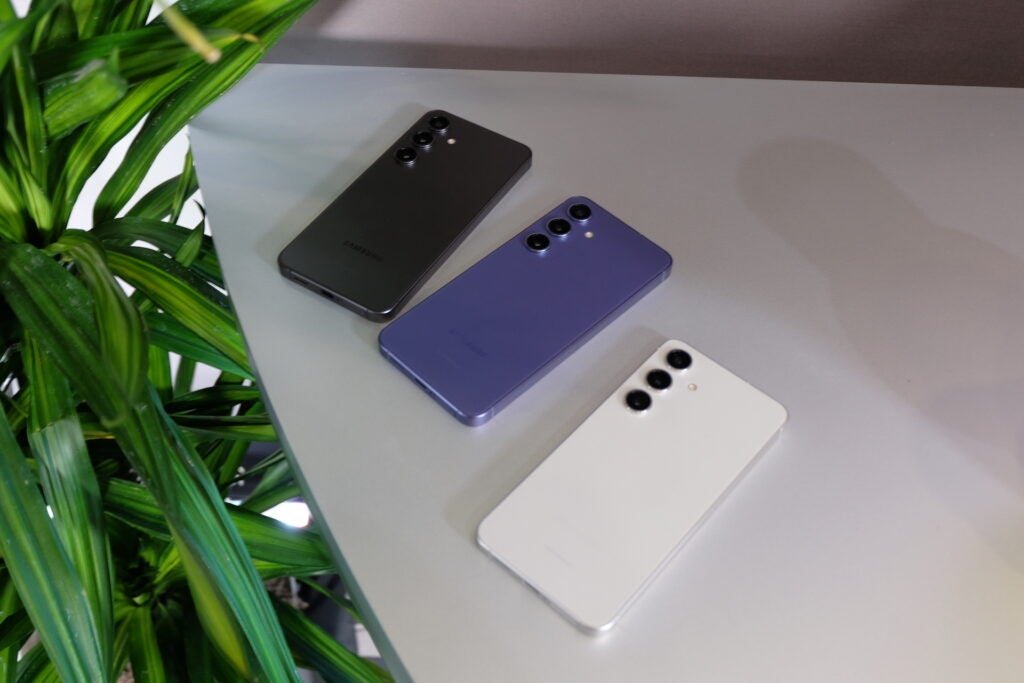
I was a little disappointed with all these colours, especially with the pastel yellow option that failed to stand out. Both the darker shades, purple and black, are quite similar – and the grey with a silver rim does little to excite.
While Samsung has shifted to a titanium rim for the S24 Ultra, the S24 and S24 Plus retain an Armour Aluminium body. I was told this upgraded material was 17% stronger than the version on the S23 series.
There is plenty of recycled material used throughout the construction, including steel in the speakers and cobalt in the battery. Samsung also continues to use 100% recycled paper in its packaging.
Performance and AI
- Galaxy AI is a big new addition
- Exynos or Snapdragon chips depending on region
There’s one very clear focus with the entire Galaxy S24 family, and that’s AI. Samsung’s Galaxy AI touches almost every part of this device, from the camera to the phone and if you watched the launch event then you’ll know that Samsung is very serious about trying to show just what its new AI system can achieve.
During my briefing, Samsung said this ’AI era’ has followed the ‘camera era’ and I wouldn’t be surprised if this signifies a change in direction for all the brand’s higher-end devices over the next few years.
A lot of the AI features here will be familiar to anyone who has followed the Google Pixel line over the past few years, especially the Pixel 8 and Pixel 8 Pro. In the phone app, for example, Galaxy AI can translate and transcribe phone calls, while in the Gallery app you can remove and resize individual elements in images.
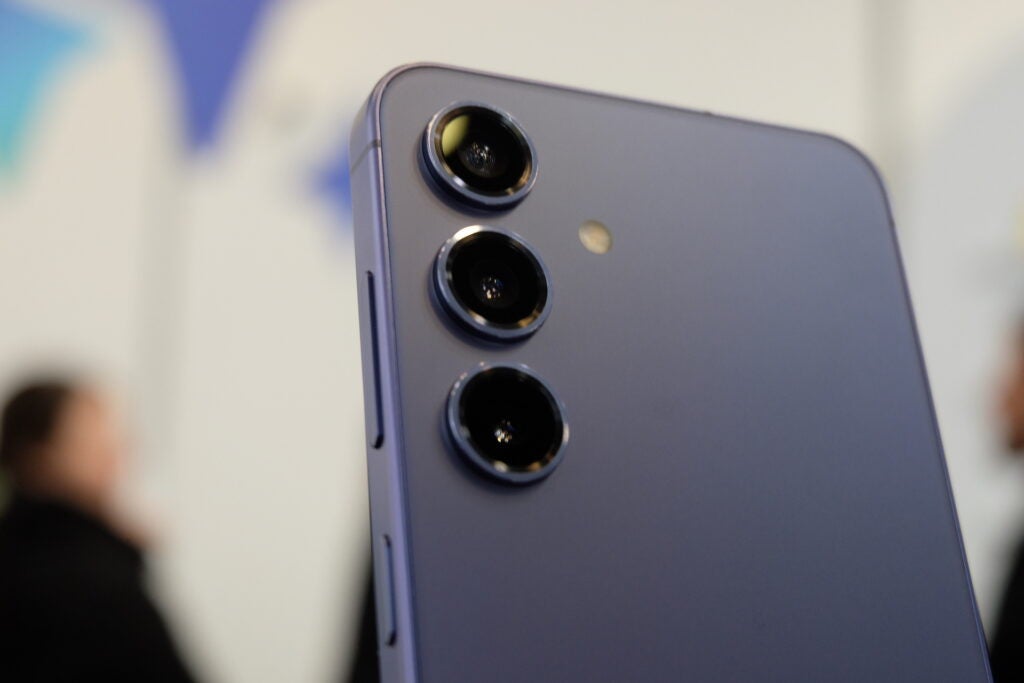
Like with the Pixel 8, there’s generative AI skills too. The editing features in the gallery app can completely change the background of an image.
An example of this was fixing a wonky shot of the Eiffel Tower with a straight one in just a few seconds. This specific use case does require an internet connection, however the majority of Galaxy AI’s skills are all done on device. Samsung reps were keen to point out that as soon as an image uses generative AI a watermark will be added and metadata included to say as much.
Samsung is using generative AI elsewhere too, notably in both the default keyboard and the Notes app. The keyboard can now write messages for you, altering your tone – formal, chatty, etc – and this works alongside the translation features. I was shown a demo of this during the session and it’ll be familiar to anyone who has used Chat GPT before. It also works very quickly and as this is done on the device, you don’t need an internet connection.
I’d say my favourite way Samsung is using AI is in the Notes app. Here you can not only transcribe a conversation (it’ll even be able to tell between different speakers) but then have the AI automatically pick out the important points and cut everything down into bullet point form. It can even format the text, adding in bolded elements, if you wish.
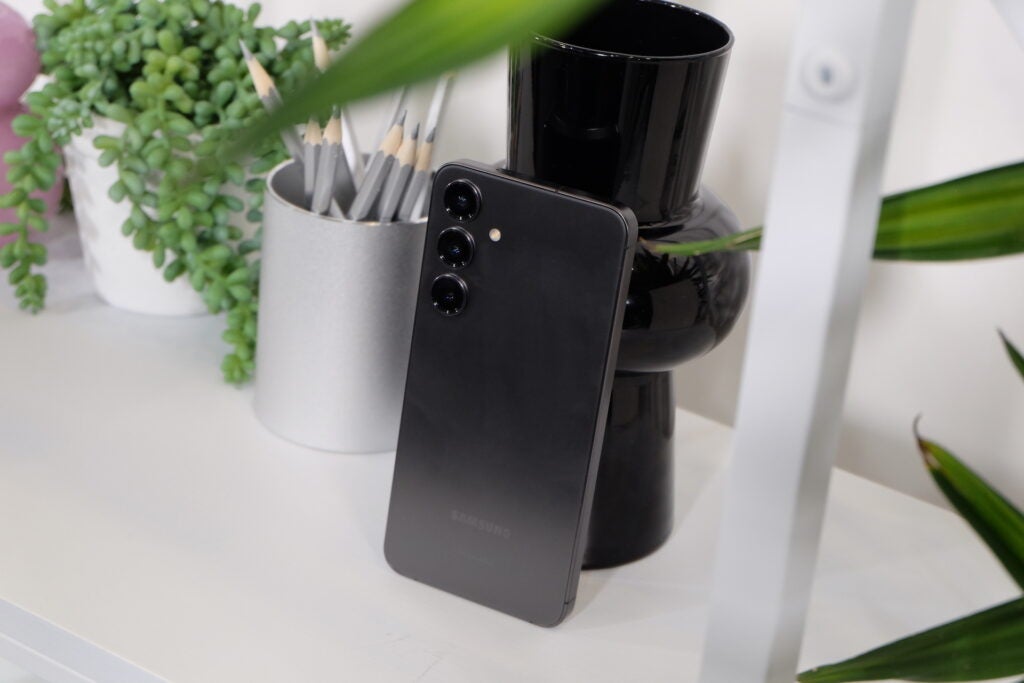
It’s hard to get a grasp on the extent of Galaxy AI after just a few hours with the device and this feels like a phone that needs to be used for an extended period to get a proper gauge on how big of an update it is. Areas like camera performance should be affected by Galaxy AI too, so even though the triple camera array on the back has seen minimal changes the photos it produces should be better – at least according to Samsung.
Now, the controversial point is that Samsung is switching back to its multi-chip strategy with the S24 series, no longer simply using Qualcomm silicone across the whole range.
In multiple regions including the UK, the S24 and S24 Plus will be powered by an Exynos 2400 for Galaxy while in the US those two phones will have the Snapdragon 8 Gen 3 for Galaxy. All regions will use the 8 Gen 3 for the Ultra.
Samsung reps were keen to point out that performance across the chips is very much the same, and none of the AI features are exclusive to a particular handset. I’ll have to reserve judgment until we’ve thoroughly reviewed all versions to see if there are any differences.
Latest deals
Initial impressions
It’s tough to judge the Samsung Galaxy S24 Plus after just a few hours of use due to its reliance on AI tech and how this kind of thing needs to be properly used daily to see the benefits.
If you remove Galaxy AI then it feels like a small upgrade. Yes, you get a brighter screen and a newer chip, but the design is very familiar and there isn’t much that feels new. However, if Galaxy AI turns out to be the real deal then this could be a very exciting 2024 flagship.
First Impressions
If you remove Galaxy AI, the Galaxy S24 Plus feels like a minor upgrade. Yes, you get a brighter screen and a newer chip but the design is very familiar and there isn’t much that feels new. However, if Galaxy AI turns out to be the real deal, this could be one to consider in 2024.
-
Bigger, brighter, better screenThe S24 Plus’ screen is not only 0.1 inches bigger than its predecessor at 6.7 inches, but it also boasts high-end tech like a LTPO-enabled 120Hz refresh rate and a maximum brightness of 2600nits to boot. -
A new focus on GenAIWith Galaxy AI, the S24 Plus can do some pretty impressive stuff, from transcribing and translating meetings to removing elements from your photos – and it all happens entirely on-device. -
Top-end performanceDespite the chipset split, regardless of whether you get the Exynos 2400 for Galaxy or Snapdragon 8 Gen 3 for Galaxy, you’ll find top-end performance with dedicated support for Generative AI.
Introduction
January is looking like a very busy month for phone launches and Samsung has kicked things off with the reveal of the Samsung Galaxy S24 series.
The Galaxy S24 Plus is the middle child of this range, offering mostly the same specs as the Galaxy S24, just with a bigger screen and battery. Then there’s the Galaxy S24 Ultra, with more camera skills and handy additions like the S Pen.
Ahead of the launch and the latest Unpacked, I had the chance to get an early look at the Galaxy S24 Plus and try out its headline Galaxy AI features.
Design and Screen
- Four new colours
- Larger, brighter OLED screen
- 1-120Hz adaptive refresh
Samsung isn’t shifting too far away from the design of the S23 Plus with the S24 Plus. It still matches the look of the smaller S24 model, mirroring the iPhone 15 in many ways with its flat sides and back.
The size, at least for me, is nearly perfect on this Plus model. It’s far comfier to hold than the larger (and heavier) S24 Ultra, while offering a more usable 6.7-inch screen than the slightly cramped 6.2-inch Galaxy S24.

All the dimensions are very similar to the outgoing S23 Plus, however Samsung did say it has slimmed the bezel down slightly to gain a 0.1-inch larger screen and that the hole punch cutout for the front camera has been reduced in size. I didn’t have an S23 Plus to hand during my briefing ahead of the launch, but you’ll likely only notice these two differences if you’re coming from last year’s model.
Aside from a minor bump in size, there is a smattering of other screen updates. It remains an AMOLED panel, but it can now alter its refresh rate between 1 and 120Hz, matching the previous Ultra devices. Samsung says the panel can now reach 2600 nits, and it should be even easier to read outside. I was shown a demo of how the S24 Plus would perform when used in direct sunlight and it did look very impressive.
Samsung has simplified the colours this time too, using the same four main hues for all models in the S24 family. These include blue, white, black and yellow. There will also be some extra exclusive colours only available via Samsung directly.

I was a little disappointed with all these colours, especially with the pastel yellow option that failed to stand out. Both the darker shades, purple and black, are quite similar – and the grey with a silver rim does little to excite.
While Samsung has shifted to a titanium rim for the S24 Ultra, the S24 and S24 Plus retain an Armour Aluminium body. I was told this upgraded material was 17% stronger than the version on the S23 series.
There is plenty of recycled material used throughout the construction, including steel in the speakers and cobalt in the battery. Samsung also continues to use 100% recycled paper in its packaging.
Performance and AI
- Galaxy AI is a big new addition
- Exynos or Snapdragon chips depending on region
There’s one very clear focus with the entire Galaxy S24 family, and that’s AI. Samsung’s Galaxy AI touches almost every part of this device, from the camera to the phone and if you watched the launch event then you’ll know that Samsung is very serious about trying to show just what its new AI system can achieve.
During my briefing, Samsung said this ’AI era’ has followed the ‘camera era’ and I wouldn’t be surprised if this signifies a change in direction for all the brand’s higher-end devices over the next few years.
A lot of the AI features here will be familiar to anyone who has followed the Google Pixel line over the past few years, especially the Pixel 8 and Pixel 8 Pro. In the phone app, for example, Galaxy AI can translate and transcribe phone calls, while in the Gallery app you can remove and resize individual elements in images.

Like with the Pixel 8, there’s generative AI skills too. The editing features in the gallery app can completely change the background of an image.
An example of this was fixing a wonky shot of the Eiffel Tower with a straight one in just a few seconds. This specific use case does require an internet connection, however the majority of Galaxy AI’s skills are all done on device. Samsung reps were keen to point out that as soon as an image uses generative AI a watermark will be added and metadata included to say as much.
Samsung is using generative AI elsewhere too, notably in both the default keyboard and the Notes app. The keyboard can now write messages for you, altering your tone – formal, chatty, etc – and this works alongside the translation features. I was shown a demo of this during the session and it’ll be familiar to anyone who has used Chat GPT before. It also works very quickly and as this is done on the device, you don’t need an internet connection.
I’d say my favourite way Samsung is using AI is in the Notes app. Here you can not only transcribe a conversation (it’ll even be able to tell between different speakers) but then have the AI automatically pick out the important points and cut everything down into bullet point form. It can even format the text, adding in bolded elements, if you wish.

It’s hard to get a grasp on the extent of Galaxy AI after just a few hours with the device and this feels like a phone that needs to be used for an extended period to get a proper gauge on how big of an update it is. Areas like camera performance should be affected by Galaxy AI too, so even though the triple camera array on the back has seen minimal changes the photos it produces should be better – at least according to Samsung.
Now, the controversial point is that Samsung is switching back to its multi-chip strategy with the S24 series, no longer simply using Qualcomm silicone across the whole range.
In multiple regions including the UK, the S24 and S24 Plus will be powered by an Exynos 2400 for Galaxy while in the US those two phones will have the Snapdragon 8 Gen 3 for Galaxy. All regions will use the 8 Gen 3 for the Ultra.
Samsung reps were keen to point out that performance across the chips is very much the same, and none of the AI features are exclusive to a particular handset. I’ll have to reserve judgment until we’ve thoroughly reviewed all versions to see if there are any differences.
Latest deals
Initial impressions
It’s tough to judge the Samsung Galaxy S24 Plus after just a few hours of use due to its reliance on AI tech and how this kind of thing needs to be properly used daily to see the benefits.
If you remove Galaxy AI then it feels like a small upgrade. Yes, you get a brighter screen and a newer chip, but the design is very familiar and there isn’t much that feels new. However, if Galaxy AI turns out to be the real deal then this could be a very exciting 2024 flagship.



















